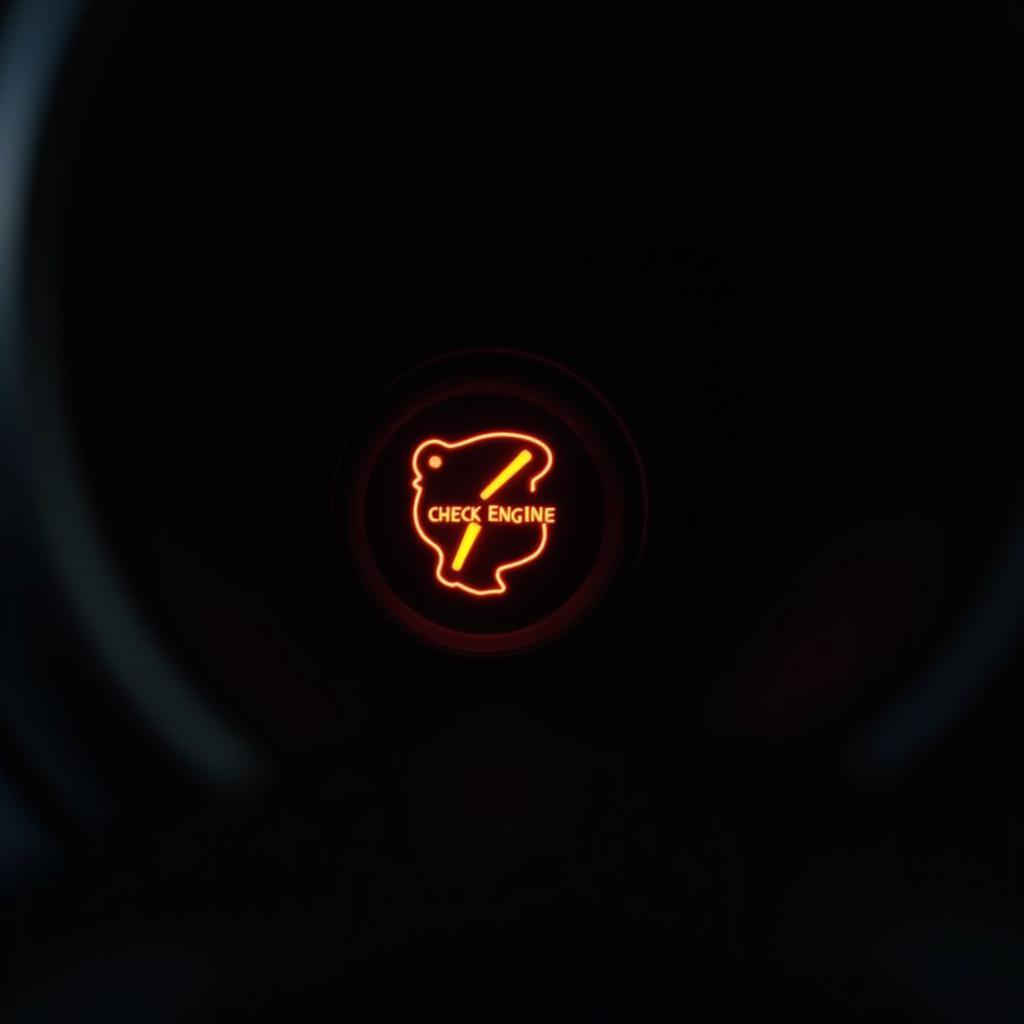Imagine this: you’re driving down the road, enjoying the scenery, when suddenly, a strange symbol illuminates on your dashboard. Your heart skips a beat. What does it mean? Car repair warning lights can be confusing and sometimes alarming, but they play a crucial role in keeping you safe and preventing costly repairs.
This comprehensive guide will delve into the world of car repair warning lights, helping you decipher their meaning and empowering you to take appropriate action.
Decoding the Dashboard: Common Car Repair Warning Lights
Your car’s dashboard is like a communication hub, with various warning lights indicating the health of different systems. Let’s shed light on some of the most common ones:
Engine Warning Light (Check Engine Light)
 Car Engine Warning Light
Car Engine Warning Light
This light, often appearing as an engine outline or the words “Check Engine,” can be a source of anxiety for many drivers. It signals a potential issue with the engine or emission control system.
Possible Causes:
- Oxygen sensor malfunction
- Loose gas cap
- Faulty catalytic converter
- Spark plug issues
What to do:
While the severity of the problem can vary, it’s crucial to have the engine warning light diagnosed and addressed promptly by a qualified mechanic. Ignoring it could lead to further damage and costly repairs.
Brake System Warning Light
This light, often represented by an exclamation mark within a circle, signals a potential problem with your braking system.
Possible Causes:
- Low brake fluid level
- Engaged parking brake
- Brake pad wear
- ABS (Anti-lock Braking System) issue
What to do:
A malfunctioning brake system is a serious safety concern. If this light illuminates, pull over as soon as safely possible and contact a mechanic immediately.
Battery Warning Light
This light, usually depicting a battery symbol, indicates a problem with your car’s charging system.
Possible Causes:
- Loose or corroded battery cables
- Failing alternator
- Failing battery
What to do:
While you might be able to drive for a short distance, it’s essential to have the battery system inspected as soon as possible. A dead battery can leave you stranded, and a faulty charging system can cause further damage.
Oil Pressure Warning Light
This light, often resembling an oil can, warns of low oil pressure in the engine.
Possible Causes:
- Low oil level
- Faulty oil pump
- Worn engine bearings
What to do:
Low oil pressure can cause severe engine damage. If this light comes on, stop driving immediately and check your oil level. If it’s low, add oil. If the light remains on, contact a mechanic.
Understanding the Urgency: Color-Coded Warning Lights
Car manufacturers use a color-coding system to indicate the urgency of the issue:
- Red: Indicates a serious problem requiring immediate attention. Stop driving as soon as safely possible and contact a mechanic.
- Yellow or Amber: Signals a potential issue that needs attention soon. It’s advisable to have your car inspected by a mechanic at your earliest convenience.
- Green or Blue: These lights indicate that a system is active and functioning normally. For example, a green light might indicate that your headlights are on.
Beyond the Basics: Other Important Warning Lights
While the warning lights discussed above are some of the most common, your car may have others, including:
- Tire Pressure Monitoring System (TPMS) Light: Indicates low tire pressure.
- Airbag Warning Light: Signals a problem with the airbag system.
- Coolant Temperature Warning Light: Warns of engine overheating.
- Traction Control Light: Indicates that the traction control system is active.
Don’t Ignore the Signs: The Importance of Addressing Warning Lights
Ignoring car repair warning lights can lead to more extensive damage and costly repairs. Addressing issues promptly can save you time, money, and potential headaches down the road.
Pro Tip from John Smith, Senior Automotive Technician at CarRepairOnline: “Think of your car’s warning lights like a doctor’s diagnosis. Ignoring them is like ignoring your health. Early detection and action are key to preventing bigger problems and keeping your car running smoothly.”
Car Repair Warning Lights: FAQs
Q1: Is it safe to drive with the check engine light on?
A1: It depends on the severity of the issue. While sometimes it might be a minor problem, it’s best to have it diagnosed by a mechanic as soon as possible to prevent potential further damage.
Q2: Can I reset my car’s warning lights myself?
A2: While you can temporarily reset some warning lights, it’s crucial to address the underlying issue. Resetting the light without fixing the problem is like silencing an alarm without addressing the fire.
Q3: What should I do if a warning light comes on while driving?
A3: If a red warning light illuminates, pull over as soon as safely possible and contact a mechanic. If it’s yellow or amber, and you’re unsure about the severity, it’s best to err on the side of caution and have your car inspected soon.
Staying Ahead of the Curve: Proactive Car Maintenance
Regular car maintenance is crucial for preventing warning lights from illuminating in the first place. By following your car manufacturer’s recommended maintenance schedule, you can address potential issues before they escalate into major problems.
Here are some helpful resources on CarRepairOnline to assist you:
- dashboard inside warning lights car repair
- repair light car
- repair car tail lights
- how to repair car lights
Conclusion: Your Guide to Navigating Car Repair Warning Lights
Understanding your car’s warning lights is an essential aspect of responsible car ownership. By familiarizing yourself with their meanings and taking prompt action when needed, you can ensure a safer and smoother driving experience while potentially extending the life of your vehicle.
